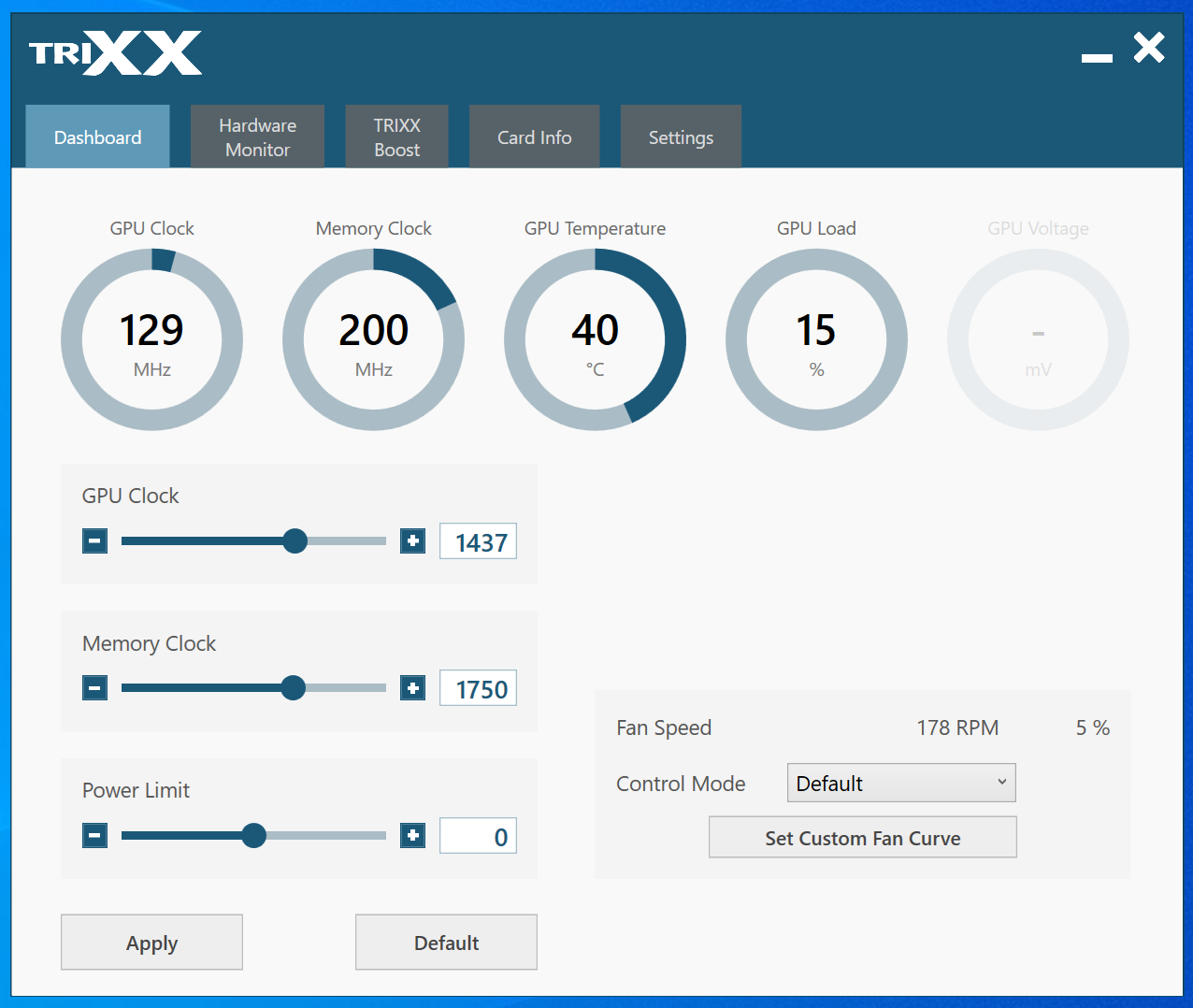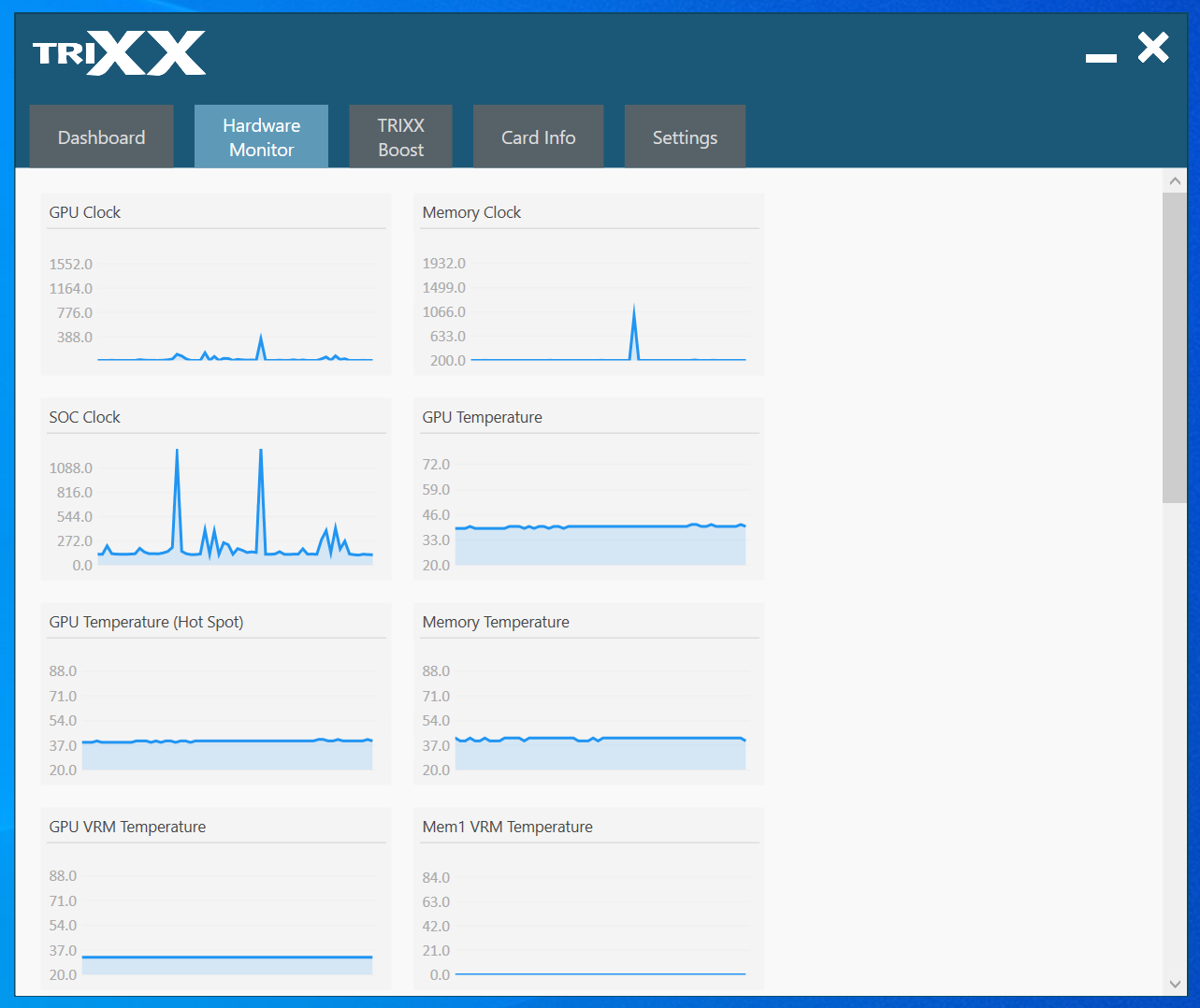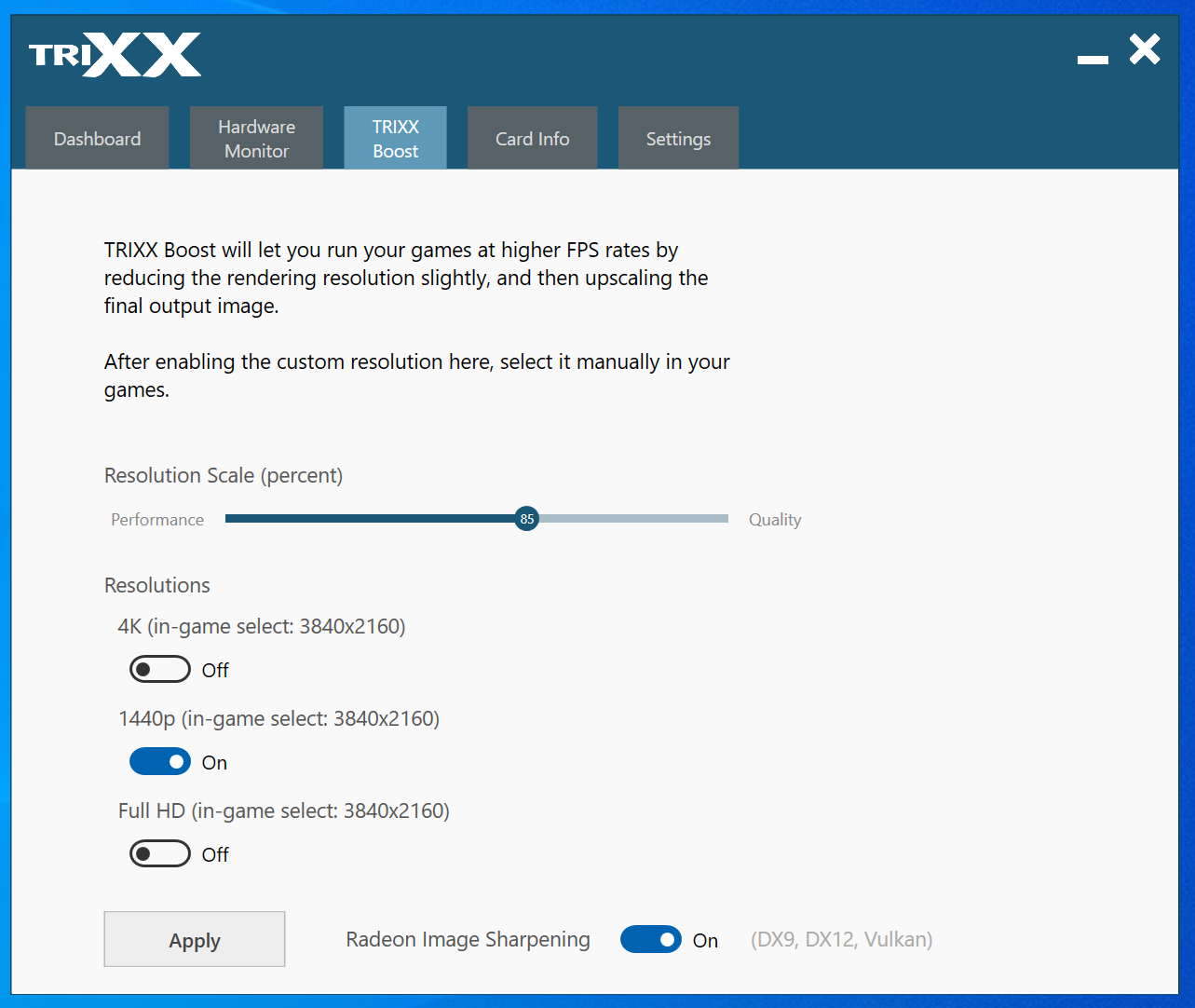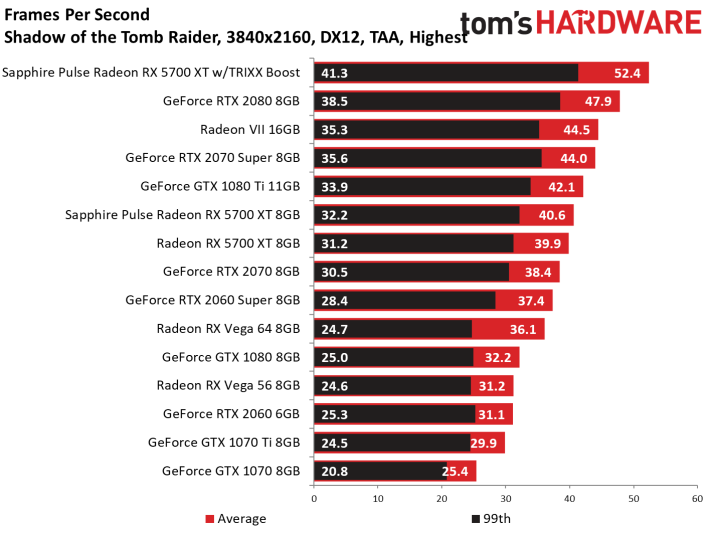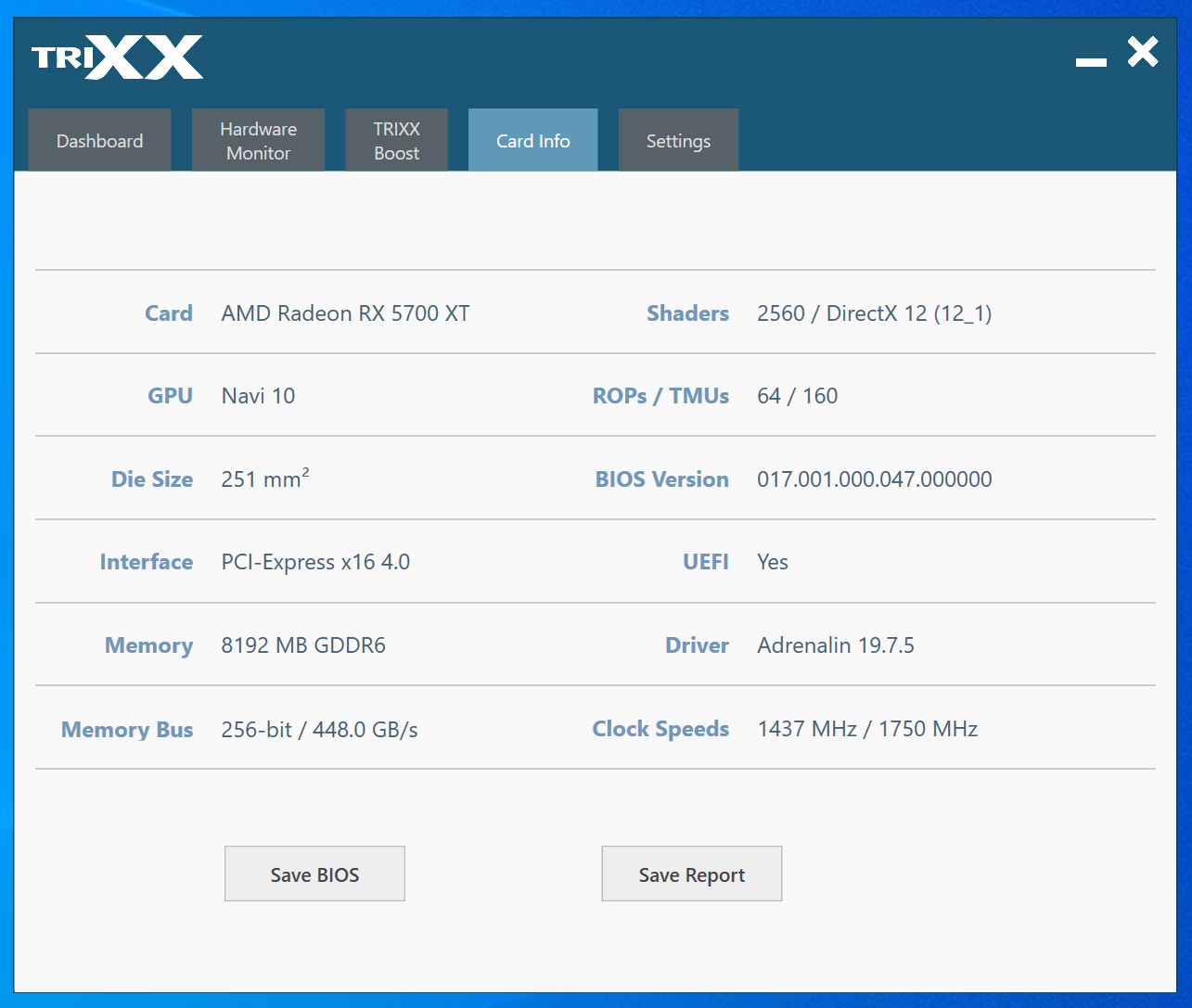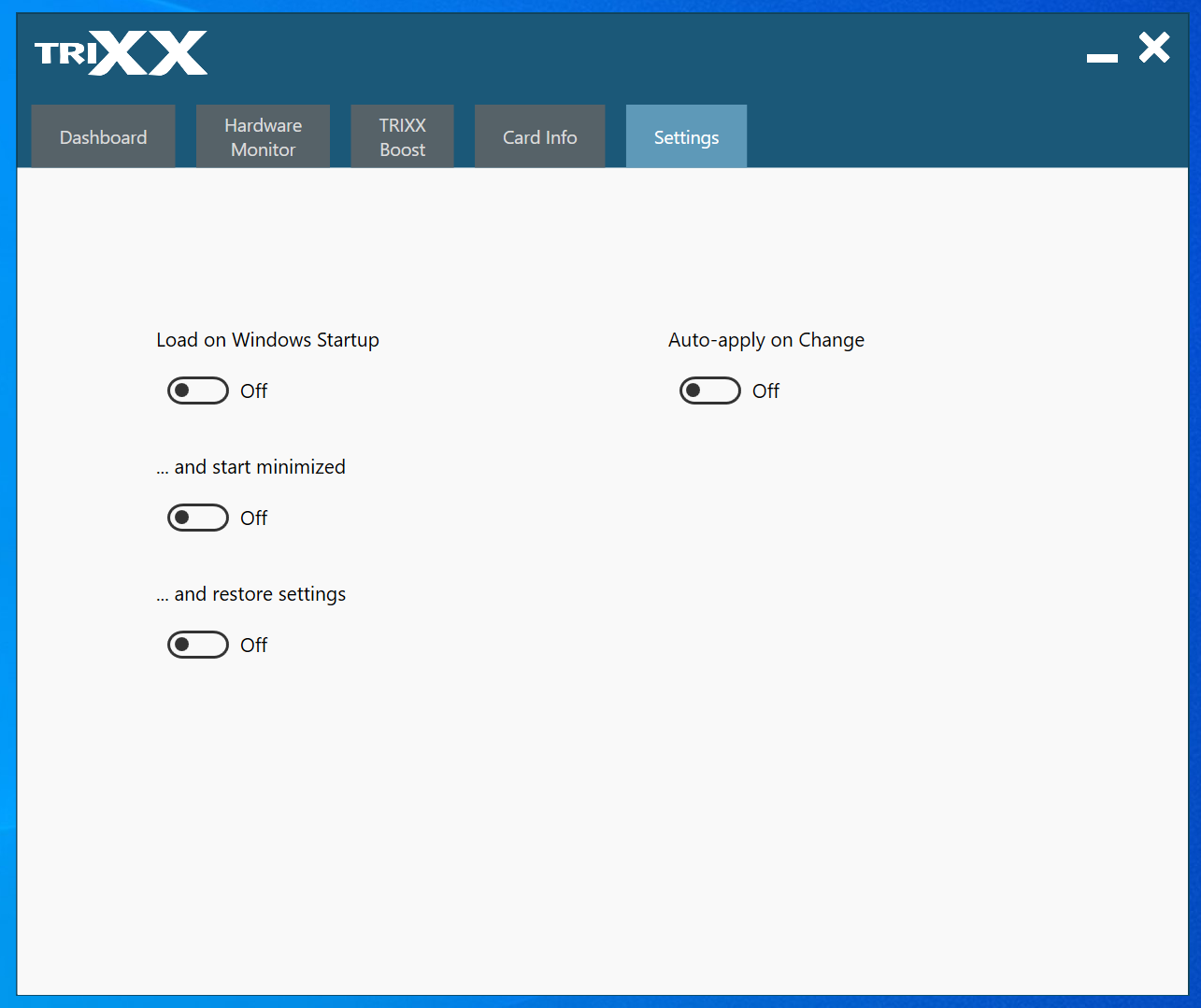Sapphire Pulse Radeon RX 5700 XT Review: Cooler and Quieter Than AMD’s Reference Card
Why you can trust Tom's Hardware
Software: Sapphire's Trixx Utility
Sapphire gave us access to an early build of its Trixx utility to try out with the Pulse Radeon RX 5700 XT.
The software’s opening screen, labeled Dashboard, includes GPU clock rate, memory clock rate, GPU temperature, and GPU load indicators. A GPU voltage field was greyed-out, consistent with what we’ve seen in GPU-Z. Three sliders underneath them control GPU frequency, memory frequency, and the card’s power limit. There’s even an option to set a custom fan curve.
The Hardware Monitor tab conveys a lot of the same information already available in GPU-Z’s Sensors tab. It’s just reflected in line graph form exclusively (we like that GPU-Z also gives you an instantaneous reading).
TRIXX Boost is Sapphire’s attempt at making upsampling plus Radeon Image Sharpening a more commonly-used combination of features. This was a big part of AMD’s Radeon RX 5700-series story that we didn’t get to explore because a proper analysis requires careful consideration of image quality. After all, you’re running games at a lower resolution, then upscaling the final output, and applying a contrast-adaptive sharpening algorithm. By default, TRIXX Boost is set to use an 85% resolution scale. At 4K, the feature creates a custom 3264x1836 resolution, which you choose instead of 3840x2160. Just remember that RIS is limited to DirectX 9, DirectX 12, and Vulkan support for now.
In the screenshot above, each mention of 3840x2160 should probably correspond to the actual target resolution Sapphire wants you to select in-game. If you use 3840x2160 as instructed, you won't see any benefit from TRIXX Boost.
Performance naturally improves quite a bit compared to native 4K. But you’ll have to decide for yourself if the trade-off in quality is acceptable. We played around with TRIXX Boost briefly in Shadow of the Tomb Raider and Metro Exodus and couldn’t tell the difference between 3264x1836 and 3840x2160. Every game is going to be different though, as will each gamer’s opinion of fidelity.
The Card Info tab conveys basic hardware and software specs; it’s purely informational.
Get Tom's Hardware's best news and in-depth reviews, straight to your inbox.
Settings gives you the option to load Trixx with Windows, to start minimized, and to apply the settings you’ve changed in the past.
MORE: Best Graphics Cards
MORE: Desktop GPU Performance Hierarchy Table
MORE: All Graphics Content
Current page: Software: Sapphire's Trixx Utility
Prev Page Fan Speeds, Clock Rates, and Temperatures Next Page Conclusion-
hannibal What was expected. Cooler, quiter version. Interesting to see what other vendors do and what prise.Reply -
Gillerer When employing upscaling+sharpening in games, ideally you don't want to set lower resolution, but use an in-game resolution scale under 100% instead. That way the UI elements and texts will still be rendered at the native monitor resolution and be perfectly crisp - those are where you're likely to first notice any fuzziness.Reply -
2Be_or_Not2Be Hmm... the review keeps on saying this board is "quieter" than the reference version, yet there are no Noise Level tests that show you how quiet it is (or isn't).Reply -
Blytz Ok, so if the pricing for me is generally that the AIB boards at the same price to 5% cheaper than the 2060 supers, for a card that nips at the heels of the 2070 (and sometimes the 2070 super depending on the game) I'd assume this is a no brainer for meReply -
iam2thecrowe Not sure if I'm blind, but I cant see anywhere in the article weather or not you test your gfx cards in a case? or in open air? In my experience this type of cooler can be problematic in some cases, particularly smaller cases.Reply -
AeroWB Chris, thanks for the great review. The amount of information packed in the review is amazing. I really like the inclusion of the Frames per Second by Percentile graphs. Unfortunately the graphs are a little small and the colors are sometimes so close its very hard to see what is what.Reply
Also I want to dare you to change the order of the cards in the graphs based on the 99 percentile values. The 99 percentile scores are more important to determine the experience than the old average FPS measurement.
For power consumption I'd like a graph with the power consumption from Metro with the other cards in the review, now I have to go to multiple reviews to compare.
Futher the review is lacking noise measurements while there are fan RPM, clock rate and temperature measurements. As a user I am more interested in noise than those other 3, as noise I can compare top other cards the other 3 measurements are less interesting and sometimes even incomparable.
In the conclusions you mention that its a good card but though its 10% faster than a GTX2060 Super its higher power consumption and lack of ray tracing make it a hard choice. As a user I am looking at performance per dollar first and performance per watt second, and I think that holds for most user. Now while ray tracing is nice feature it cannot be used in the majority of games and especially in this segment enabling ray tracing is a tough trade off as you probably will see more stuttering (or you will need to lower other graphics settings, can that a be good trade ever?)
So my conclusion would be reversed. The RX5700XT is the default choice in this price and only if you need to limit power consumption (for example if your case has bad cooling) or if you'd really want to do ray tracing the GTX2060 becomes the better option. Also the Sapphire RX5700XT is 10% faster on average over the average FPS of the 13 games. If we look at 99 percentile its 12% faster, again not much but still a good bit. Also the drivers are less matured so you could a expect a little more improvement from that side too.
Its not such an easy the choice as the Ryzen 3000 is compared to the Core i5/7 at this moment where the former is better in almost all aspects, but I think the RX5700XT is the better choice for most gamers shopping around this price. -
King_V Given how, with Sapphire's previous cards, the Pulse was the "good" cooler, and the Nitro/Nitro+ had the "even better" cooler, I'd be curious to see how their Nitro cooling solution does, when they release one for the 5700XT.Reply -
spigias ReplyAeroWB said:Chris, thanks for the great review. The amount of information packed in the review is amazing. I really like the inclusion of the Frames per Second by Percentile graphs. Unfortunately the graphs are a little small and the colors are sometimes so close its very hard to see what is what.
Also I want to dare you to change the order of the cards in the graphs based on the 99 percentile values. The 99 percentile scores are more important to determine the experience than the old average FPS measurement.
For power consumption I'd like a graph with the power consumption from Metro with the other cards in the review, now I have to go to multiple reviews to compare.
Futher the review is lacking noise measurements while there are fan RPM, clock rate and temperature measurements. As a user I am more interested in noise than those other 3, as noise I can compare top other cards the other 3 measurements are less interesting and sometimes even incomparable.
In the conclusions you mention that its a good card but though its 10% faster than a GTX2060 Super its higher power consumption and lack of ray tracing make it a hard choice. As a user I am looking at performance per dollar first and performance per watt second, and I think that holds for most user. Now while ray tracing is nice feature it cannot be used in the majority of games and especially in this segment enabling ray tracing is a tough trade off as you probably will see more stuttering (or you will need to lower other graphics settings, can that a be good trade ever?)
So my conclusion would be reversed. The RX5700XT is the default choice in this price and only if you need to limit power consumption (for example if your case has bad cooling) or if you'd really want to do ray tracing the GTX2060 becomes the better option. Also the Sapphire RX5700XT is 10% faster on average over the average FPS of the 13 games. If we look at 99 percentile its 12% faster, again not much but still a good bit. Also the drivers are less matured so you could a expect a little more improvement from that side too.
Its not such an easy the choice as the Ryzen 3000 is compared to the Core i5/7 at this moment where the former is better in almost all aspects, but I think the RX5700XT is the better choice for most gamers shopping around this price.
Great comment, thank you AeroWB, your conclusion is much better than Chris.(opinions respected of course) . Had to visit other tech sites for a comparisons too. Makes me wonder what happened to this site. -
Minnefornian Did they say when will the TriXX software be available for the Pulse? The current version crashes upon launch for me.Reply
